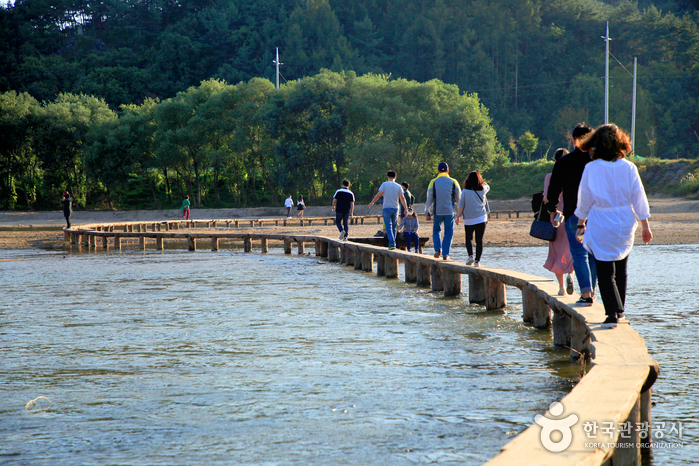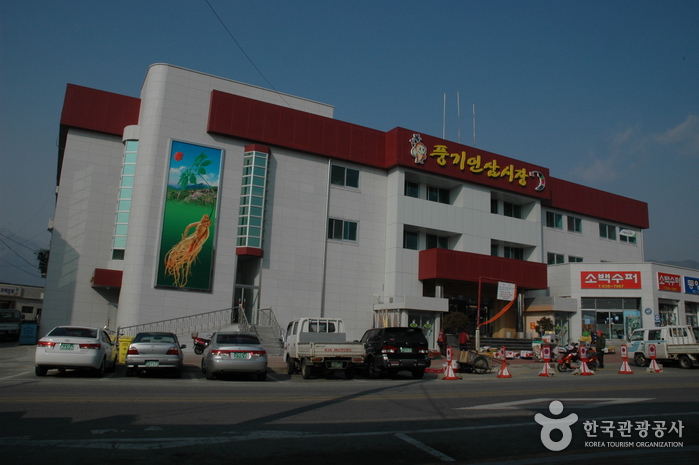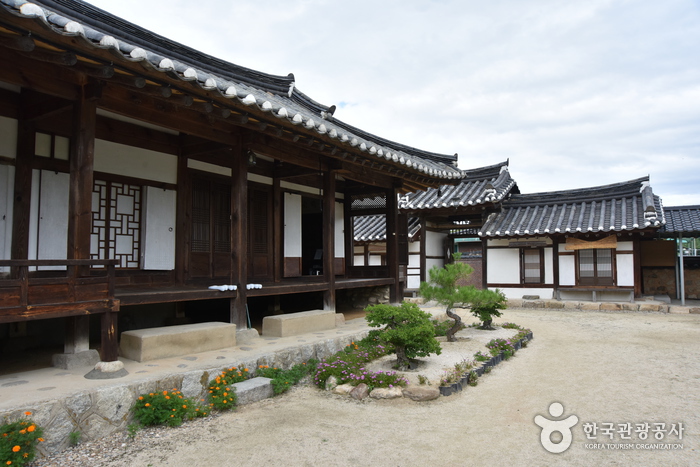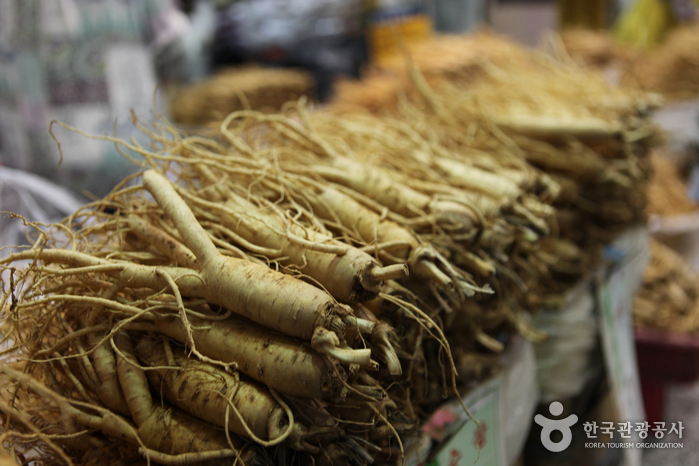Hamheung Myeonok (함흥면옥)
0m 146 2016-09-05
109-10, Jungang-ro, Yeongju-si, Gyeongsangbuk-do
Hamheung Myeonok is a family operated business for three generations mainly serving ‘naengmyeon’ (cold noodles) and ‘galbi’ (grilled ribs).
A well-known place in Yeongju, Hamheung Myeonok offers the second floor especially for groups.
Cleanliness and hygiene are most emphasized by the owner.
Hand kneaded cold noodles are extra chewy and their North Korean style ‘bulgogi’ (marinated barbeque beef) are quite famous.
Also, try their ‘galbi Jjim’ (marinated and simmered ribs) which is combined with Korean herbal medicine providing a healthy dining choice for visitors.
Excellent service, atmosphere and food.
Overall a superb restaurant.
Terminal de Bus Yeongju
709.1565241459282m 12308 2015-12-03
497 Yeongju-dong Yeongju-si Gyeongsangbuk-do
Gare de Yeongju (영주역)
1.5 Km 467 2015-12-02
경상북도 영주시 선비로 64
영주역은 1941년 7월 1일 보통역으로 영업을 개시하여 1973년 12월 23일 현역사로 이전하였다.
청량리 기점 213.2 km지점에 위치하며 중앙선에서 영동선과 경북선이 분기하는 시종착역이고, 경북본부의 영주관리역(영주역,희방사역, 풍기역, 문수역, 평은역)으로 모든 열차가 정차하고 있다.
경북 북부지역의 교통의 요충지로 십여년전까지도 이용객이 가장 많은 전성기를 누렸으나, 도로교통의 발달로 이용고객이 현저히 줄어왔다.
앞으로 2018년까지 중앙선복선화가 완전히 이루어질 것으로 예상되며 영주-청량리간 소요시간이 1시간 10분까지 단축될 것으로 전망되어 직원들의 기대가 상당히 높다.
Village de Museom à Yeongju (영주 무섬마을)
10.5 Km 4036 2021-05-25
31-12, Museom-ro 234beon-gil, Yeongju-si, Gyeongsangbuk-do
+82-54-638-1127
Situé à Sudo-ri (Munsu-myeon, Yeongju, province du Gyeongsangbuk-do), le village de Museom est une charmante bourgade de hanok entouré d’eau. Les rivières de Naeseongcheon et de Yeongjuchon prennent leur source aux monts Sobaek et Taebaek, et convergent vers le village de Museom, l’entourant d’eau par trois côtés. Ce village semblable à une île est non seulement un haut lieu de la culture traditionnelle coréenne, mais il possède également un environnement naturel splendide, complété par une grande plage de sable et une forêt luxuriante.
Célèbre pour les maisons Haeudang et Manjukje (deux des hanoks les plus historiques de la région), le village est également connu pour ses exceptionnelles maisons traditionnelles comme la maison de Kim Gyu-jin et la maison de Kim Wi-jin. Manjukje est située au coeur du village, et elle est également appréciée par les visiteurs internationaux comme étant la plus ancienne maison traditionnelle du village de hanok. Manjukje a été construite en 1666 (lors de la 7ème année du règne du roi Heonjong) par Bak Su (le patriarche de la famille Bak de Bannam).
Près de Manjukje se trouve la maison Manun, construite au début du XIXème siècle et baptisée d’après Kim Hwi-geol, dont le nom de plume est « Manun ». La maison est devenue plus tard la résidence de l’épouse du célèbre poète Jo Ji-hun, auteur de « Byeolli », un poème exprimant la beauté du village de Museom.
Parmi les autres maisons notables, on peut citer celle de Kim Jin-wi (une maison appartenant à des aristocrates), celle de Kim Jeong-gyu (une maison dépourvue de la clôture extérieure traditionnelle) et celle de Jae-yeon, où les écrits de Bak Gyu-su (lettré appartenant à l’école de pensée Silhakpa à la fin de la dynastie Joseon) se trouvent encore aujourd’hui.
Le Pont de l’Unique Rondin constitue une autre attraction du village. Ce pont a représenté le seul lien avec le monde extérieur pendant plus de 250 ans, avant la construction du pont de Sudo en 1979. Il est minuscule en largeur (30 cm) mais On dit qu’il était reconstruit chaque année après avoir été détruit à chaque saison des pluies. Avec la construction du pont de Sudo, le Pont de l’Unique Rondin était inutile, mais il a été reconstruit quelques temps après sous sa forme originale. Pour rendre hommage à l’histoire impressionante du pont, le festival Oeinamu Dari (qui signifie Festival du Pont de l’Unique Rondin) a lieu tous les jours en octobre.
Marché de Ginseng de Punggi (풍기인삼시장)
10.5 Km 11156 2021-05-17
8, Insam-ro, Yeongju-si, Gyeongsangbuk-do
+82-54-633-7948
Le marché de ginseng de Punggi, le plus ancien dans la région de Punggi, est creonnu pour sa gamme de produits à base de ginseng. Tous les 3ème et 8ème jours du mois, un marché traditionnel (se rendant dans plusieurs villes dans la région) ouvre ses portes près du marché de ginseng durant 5 jours, donnant au lieu une atmosphère traditionnelle et nostalgique.
Sogang House
10.8 Km 5128 2021-04-09
22, Baraemi-gil, Bonghwa-eup, Bonghwa-gun, Gyeongsangbuk-do
+82-10-9189-5578
The House of Sogang is an approximately 110-year-old house located in the village of Baraemi in Bonghwa-gun, Gyeongsangbuk-do. It was originally built for and presented to Kim Chang-gi (pen-name: Sogang), a well-known local Confucian scholar who served as the head of the Dosanseowon Confucian Academy, and who happened to be the second son of Kim Roe-sik (pen-name: Namho), the great-grandfather of the current owner.
Furthermore, the House of Namho, which is situated behind the House of Sogang, was built for the first son of Kim Roe-sik, one of the richest men in the region, who borrowed money using his entire property as security and donated it to a war chest. He won an official commendation for his role in helping secure national independence in 1977.
The entire village pf Baraemi is composed of traditional square-shaped houses with tiled roofs set amid a clean and peaceful atmosphere, for which it was designated as a Traditional Cultural Village way back in 1922. The name of the village, Baraemi, implies that it was originally situated by the sea, and many shell remains have been found in paddy fields and puddles there over the last 60 years.
The House of Namho is a typical square-shaped house with a tiled roof, and comprises a tall gate, a front courtyard, a sarangchae (men’s quarters) with maru (wooden floor), an inner courtyard, and a bonchae (main building) among its various structures. The main construction material of the house is Chunyang pine wood, which is a rarely used these days. Thanks to the owner-family’s dedicated maintenance and care, the house has been preserved in good condition. As the typical residence of a nobleman of the late Joseon period, the house is decorated with simple interior objects including an old electric fan and a cabinet inlaid with mother-of-pearl.
The house has seven guestrooms in total: The sarangchae consists of the Keunsarang and Jakeunsarang, each with a capacity of 4 to 5 people, and the Araetbang with a capacity of 2 to 3 people. In summer, guests can rent the Jakeunsarang and Sarangdaecheong together, or the Araetbang and Marutbang together, in order to have more space.
In addition, the anchae has a sangbang with a capacity of 3 to 4 people, while the mugangchae consists of Mungangbang 1, which is a red clay floor-heated room, and Mungangbang 2, which can accommodate 2 to 5 people. In summer it is possible to rent the entire House of Sogang, which can accommodate anywhere from 22 to 34 people (if the Sarangmaru and Marutbang are also rented).
Guests of the Keunsarang and Jakeunsarang can use a communal refrigerator, and the entire building has Wi-Fi access. Clean bedding is also provided. Although the house doesn’t provide a breakfast, the owner offers guests sweetcorn, sweet potatoes, fruit, etc. The house is also equipped with a BBQ facility, so guests can enjoy a BBQ party in the evening.
Guests can easily reach various nearby cultural heritage sites, including Muryangsujeon Hall of Buseoksa Temple, Sosuseowon Confucian Academy, which was the first Confucian Academy of Korea, Ojeon Mineral Spring, Daksil Village, and Chukseosa Temple.
The Namho house [Korea Quality] / 남호구택 [한국관광 품질인증]
10.9 Km 117 2020-09-03
21, Baraemi-gil, Bonghwa-gun, Gyeongsangbuk-do
+82-54-673-2257
Located in Bonghwa-eup, Bonghwa-gun, Gyeongsangbuk-do, Bonghwa Namho Gutaek is an old house from the Chosun period designated as Cultural Property Material No. 385. It was built by Nongsan Kim Nam Yeong in 1876 and his son Namho Kim Roe Sik had lived there. Mr. Kim Roe Sik was awarded with a medal for contributing his entire asset to military fund for the Provisional Government of Korea. The spirit of putting others and his country before himself continues until now. Having been built with high-quality materials, the 140-year old Namho Gutaek has barely suffered any deformation. In addition, attentive care added by the descendants has kept the traditional beauty of the hanok intact. One may even feel reverence at the Sosel Daemun (gate). In harmony with the hanok, the garden in the yard and the flower bed sitting next to the wall change color as season changes. It is a great place to feel the scent of old trees and get some rest. In 2016, the shared toilet was renovated in modern style to alleviate any inconvenience for the guests. In the spacious yard, there’s a spot for traditional games such as Tuho, Jegichagi, Neoltuigi, etc. Bonghwa Station (Yeongdong Line) is about a 15- minute walk away; an inner city bus stop in the town, on the other hand, makes a trip to other regions easy.
Festival du Ginseng de Punggi à Yeongju (영주 풍기인삼축제)
11.0 Km 5016 2019-08-28
Baek-ri, Punggi-eup, Yeongju-si, Gyeongsangbuk-do
054-635-0020
Le ginseng Pung-gi, réputé pour sa qualité, ne pousse que dans les montagnes Sobaeksan. Le festival coincide avec la saison de récolte du ginseng, aux alentours d'octobre.
La raison de la popularité du ginseng Pung-gi est sa forte concentration en ‘saponin’, qui aide à réguler la pression sanguine, à prévenir le cancer et à revitaliser le corps. Vous pourrez cuiellir vous même le ginseng et goûter à des plats à base de ginseng Pung-gi. De nombreux sites touristiques se trouvent dans la région Yeongju, comme le temple Buseoksa et les sources thermales Sobaeksan Pung-gi.
Tohyang traditional house [Korea Quality] / 토향고택 [한국관광 품질인증]
11.2 Km 10790 2020-09-10
43, Baraemi 1-gil Bonghwa-eup, Bonghwa-gun, Gyeongsangbuk-do
+82-10-8575-9036
This historic house has been the home of the descendants of Kim Yeo-byeong, one of the tenth-generation ancestors of its current occupants. Kim Yeo-byeong was born as the fourth son of Kim Seong-gu (courtesy name: Oheon, 1641-1707), founder of Uiseong Kim's Clan at Baraemi Village in Bonghwa and who was a great-great-great grandson of eminent Neo-Confucian official-scholar Kim U-goeng (courtesy name: Gaeam, 1524-1590). The house is comparatively large, featuring a square layout with a lofty five-bay gate building (soseuldaemun) and the main house of seven bays. The main building (anchae) of the house, located against the backdrop of a pine hill, is believed to have been built over 400 years ago before the founder of the family arrived at the village. The family guesthouse (sarangchae) was renovated in 1876 by Kim In-sik (courtesy name: Amun, 1855-1910), who served as the caretaker (Chambong) of Sunghyejeon Shrine, and Grand Master Tonghun before founding Joyang School, which would later become the present-day Bonghwa Elementary School. The name of the house, Tohyang, came from the courtesy name of Kim Jung-uk (1924-1967), a grandson of Kim In-sik. The latter was conscripted by the colonial authority ruling Korea at the time to serve the Japanese puppet state Manchukuo but fled during a military drill to become a freedom activist fighting against Imperial Japan in the Chinese cities of Suzhou and Hangzhou. He returned home after the 1945 Korean Liberation and studied in Jungang High School and Korea University before serving as a budget officer at the Economic Planning Board. The name of the house inscribed on the plaque hung under the roof of the gatehouse was written by his son Kim Jong-gu in honor of his life and achievements. At the front courtyard of the house is a lotus pond including barbecuing equipment and pottery kiln. In the rear garden is a folk playground with facilities and equipment for swinging, traditional Korean seesaw, shuttlecock-kicking, pitch-pot, and top spinning. The front courtyard also features rustic ceramic pots and rooftiles bearing poetic passages written by the mistress of the house who is a prize-winning poetess. The house provides visitors with an opportunity to experience traditional Korean cultural heritage such as pottery, calligraphy, poetry, and traditional musical instruments. Rich with the heritage of traditional Korean culture and lifestyle, the Historic House of Tohyang guides visitors to refreshment and healing obtained from the legacy of the peaceful rural life of days gone by.
Manhoegotaek [Korea Quality] / 만회고택 [한국관광 품질인증]
11.3 Km 3568 2020-09-08
51, Baraemi 1-gil, Bonghwa-eup, Bonghwa-gun, Gyeongsangbuk-do
+82-54-673-7939, +82-10-7424-7280
Manhoe Historic House is located in the village of Baraemi, whose name means “a village under the sea.” As a place where literary and intellectual endeavors have flourished since ancient times, Manhoe Historic House’s representative structure is Myeongwolu Pavilion, where ancestors studied and recited poetry amid the beautiful landscape of Sobaeksan Mountain. It is said that about 1,000 poems were composed at the pavilion in the old days.
The house is also the birthplace of the independence movement in Korea. Local Confucian scholars led by Independence activist Kim Chang-suk gathered together at the pavilion right after the March 1st Movement in 1919 and wrote the petition for Korea’s Independence, which was eventually submitted to the Paris Peace Conference. Recently, many hundreds of letters exchanged between independence activists were also discovered at the house.
The house is a square-shaped hanok structure consisting of a ‘ㄷ’-shaped anchae (women’s quarters), a ‘ㅡ’-shaped sarangchae (men’s quarters), a jungmunganchae (middle gate building), and a courtyard. The anchae, which is over 320 years old, has been inhabited by the descendants of Kim Geon-su, a civil official of the late Joseon period, for six generations, The sarangchae, which is over 200 years old, was added to the original house at a later date.
The house was mainly built with red and solid Chunyang pine wood, and is well preserved as a result. The sarangchae has a half-hipped roof, and comprises a sarangbang (main room), daecheong (main floored room), geonneonbang (a room opposite the main room), and toenmaru (a narrow wooden porch running along the outside of the building). The guestrooms of the sarangchae and jungmunganchae include the Sarangbang, Seonangsil, and Baraemisil Rooms, of which the Sarangbang and Seonangsil are equipped with an individual indoor bathroom.
In particular, the anchae is a cozy well-insulated building comprising a daecheong in the middle, a sangbang room on the left, and a gobang (storeroom) and anbang (main room) on the right.
Every room of the anchae is decorated with paintings by the owner’s daughter, fabric artworks, and antique wooden furniture. The anbang, which has an attic and indoor bathroom, can accommodate up to eight people. Guests of the sangbang and gobang need to use the external bathroom.
Right next to the house is a farm covering an area of 6,600m2 where over 100 kinds of crops are cultivated organically, including wildflowers, sweet potatoes, tomatoes, corns, peanuts, salad leaves and other vegetables, which are available for guests. Although the house doesn’t provide a breakfast, guests can pick vegetables in the field and cook them in the communal kitchen or at the BBQ facility in the outer yard. Meanwhile, the nearby Songyigukbapjip restaurant specializes in the delicious local dish made with pine mushrooms.
The house provides a variety of traditional experience activities including Tuho (stick throwing), Seunggyeongdo (chess), Neolttwigi (Korean jumping game similar to see-saw), Sijo composition (traditional Korean three-verse poem), a traditional musical instrument experience (six-stringed Korean zither, seven-stringed instrument, gong, etc.), and a woodblock printing experience.




![The Namho house [Korea Quality] / 남호구택 [한국관광 품질인증]](http://tong.visitkorea.or.kr/cms/resource/90/2626090_image2_1.jpg)

![Tohyang traditional house [Korea Quality] / 토향고택 [한국관광 품질인증]](http://tong.visitkorea.or.kr/cms/resource/57/2627457_image2_1.jpg)
![Manhoegotaek [Korea Quality] / 만회고택 [한국관광 품질인증]](http://tong.visitkorea.or.kr/cms/resource/64/2579364_image2_1.jpg)
 Français
Français
 한국어
한국어 English
English 日本語
日本語 中文(简体)
中文(简体) Deutsch
Deutsch Español
Español Русский
Русский